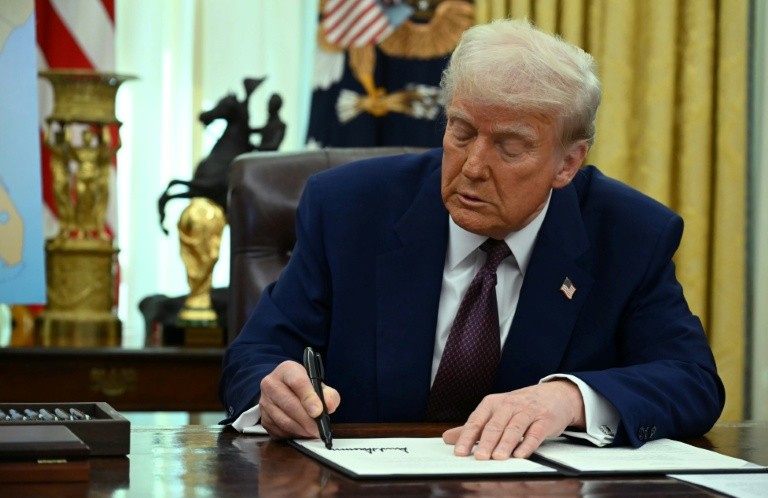
U.S. President Donald Trump on Friday revealed that he intends to impose tariffs on imported cars starting around April 2. This decision could have a substantial impact on automakers from Japan, Germany, and South Korea, potentially disrupting their operations and trade with the United States.
The tariffs are part of a broader strategy, and their implementation could lead to higher costs for both manufacturers and consumers.
Trump did not provide specific details regarding which countries would be affected by the tariffs. During a conversation with reporters in the Oval Office, he humorously mentioned, "I would have done them on April 1. I'm a little superstitious." He explained that delaying the tariffs by just one day would save a significant amount of money, but he confirmed that the tariffs would likely be rolled out on April 2. His comments highlighted a blend of lightheartedness and seriousness regarding the upcoming trade decision.
Trump's ambiguous announcement came just a day after he directed administration officials to begin preparations for the implementation of reciprocal tariffs. Howard Lutnick, his nominee for Commerce Secretary, suggested that these tariffs could be imposed as early as April 2. The timing of the announcement raised further questions about the potential impact on international trade relations, especially with key automakers from countries like Japan, Germany, and South Korea. While Trump's comments remained vague, the administration's efforts to prepare for the tariffs signaled that the move was likely imminent.
It was not immediately clear whether the proposed auto tariffs were part of a larger strategy by the administration to raise import taxes on certain products. This move could be in response to the tariffs imposed by other countries on U.S. goods, as part of an effort to equalize trade terms. While the specifics of this plan remain uncertain, it is likely that the administration's broader approach will focus on matching or retaliating against foreign tariffs on American-made products. The lack of detailed information has left many questions regarding the full scope and potential impact of these tariffs.
"For many years, the U.S. has been treated unfairly by other countries, both friend and foe," Trump said on Thursday, as he ordered an investigation into the trade conditions between the United States and other nations.
Since resuming the presidency for a nonconsecutive second term on January 20, Trump has also implemented an additional 10 percent duty on goods imported from China. His proposed hefty tariffs on imports from Canada and Mexico have been temporarily put on hold for 30 days to allow for ongoing negotiations with the neighboring countries.
So far, Trump has announced three distinct types of tariffs: country-specific tariffs, sector-based tariffs, and reciprocal duties. Each type reflects his broader trade strategy aimed at addressing perceived imbalances and protecting U.S. industries.
The U.S. market serves as the largest export destination for Japanese automakers, representing about a third of their total exports. In 2023 alone, they exported around 1.44 million passenger cars to the United States, a significant figure that underscores the importance of the U.S. as a key market for Japan's automotive industry. This data, provided by the Japan Automobile Manufacturers Association, highlights the economic interconnectedness between the two nations and the potential impact that any tariffs or trade policies could have on the flow of vehicles between the countries.
Similar to their competitors, many major Japanese automakers also export finished vehicles to the U.S. from plants in Canada and Mexico, both of which have a free trade agreement with the United States. If tariffs were to be imposed on these neighboring countries, the impact on the automotive industry would be even more significant. This is because a large portion of vehicles sold in the U.S. from Japanese manufacturers is produced in these plants, and any additional tariffs could lead to higher production costs and disrupt the flow of exports to the key American market.
Japan does not impose tariffs on imported cars, trucks, and buses, while the U.S. government applies tariffs of 2.5 percent on passenger vehicles, 25 percent on trucks, and 2 percent on buses imported from Japan. In contrast, the United States has a free trade agreement with South Korea, and as a result, no tariffs are levied on cars imported from either country. This distinction in trade policies underscores the varying tariff structures between the U.S. and its key trade partners in the automotive sector.
Trump has consistently argued that tariffs will protect U.S. industries and help reduce the country's trade deficits, unveiling a 25 percent tariff on all steel and aluminum imports this past Monday. These tariffs are set to take effect on March 12.
Addressing Nippon Steel Corp.'s blocked plan to acquire United States Steel Corp., the president reiterated on Friday that while he opposes full ownership by the Japanese company, he would not object to Nippon Steel taking a minority stake in the struggling American steel producer. This stance reflects his broader approach to trade, balancing protectionist measures with a willingness to allow foreign investment under certain conditions.
Originally published on IBTimes
© Copyright IBTimes 2024. All rights reserved.








